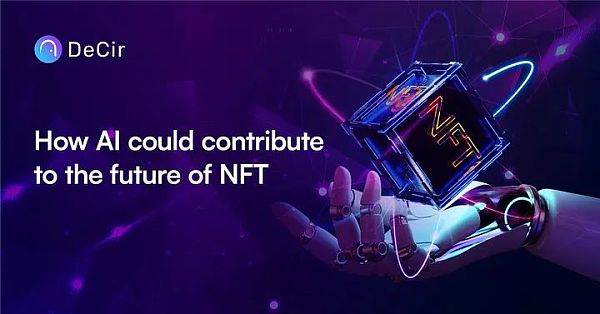Author: DeCir.io
Non-fungible tokens (NFTs) have gained significant attention in recent years, revolutionizing the digital art and collectibles market. As this technology continues to evolve, the adoption of artificial intelligence (AI) presents exciting possibilities for the future of NFTs.
In brief:
-
AI can generate original digital art, verify its authenticity, and enhance curation and recommendation systems.
-
Based on an artist’s reputation, market trends, and historical sales data, AI-based models can provide accurate valuations, helping artists and collectors make informed decisions.
-
Integrating AI into the NFT market can improve search functionality, introduce reputation systems, and enhance security.

Content Generation and Creativity
AI has a significant impact on NFT content generation and creativity. AI algorithms can generate unique and original digital art, pushing the boundaries of artistic expression.
By leveraging machine learning techniques, AI can learn from existing art, analyze patterns, and create new works that fit an artist’s style or a specific theme. The fusion of human creativity and AI’s computational power will produce a large number of novel and engaging NFT works.
Authenticity Verification and Traceability
One fundamental challenge faced by the NFT space is verifying the authenticity and traceability of digital assets. AI plays a crucial role in addressing this issue. By adopting computer vision and image analysis algorithms, AI can detect and track unique features in digital art, creating verifiable digital fingerprints.
This ensures the tamper-proof nature of NFTs, reliably tracing their origins and ownership, and enhancing trust and transparency in the ecosystem.
Authenticity Verification and Source
One of the fundamental challenges in the NFT space is verifying the authenticity and source of digital assets. Artificial intelligence can play a crucial role in addressing this issue [1]. By adopting computer vision and image analysis algorithms, AI can detect and track unique features in digital art, thus creating verifiable digital fingerprints.
This can ensure that NFTs remain tamper-proof and can be reliably traced for their origin and ownership, thus enhancing trust and transparency in the ecosystem.
Planning and Personalized Recommendations
In the vast NFT market, discoverability is crucial. AI-driven recommendation systems can provide personalized suggestions based on user preferences, past interactions, and browsing history, helping users navigate this space.
Read also: Three challenges facing global creators[2]
By analyzing vast amounts of data, AI algorithms can identify patterns, understand user behavior, and devise tailored recommendations. This can improve overall user experience, increase engagement, and promote exploration of new and exciting NFTs.
Pricing and Valuation
Determining the value of NFTs can be challenging due to multiple factors, such as artist reputation, scarcity, and market trends. AI-based pricing models can leverage data analysis and historical sales data to provide more accurate valuations.
These models can take into account factors such as an artist’s previous sales, social media engagement, and market demand to offer insights on fair pricing. Such AI-driven pricing mechanisms can benefit both artists and buyers, with artists gaining better insight into the value of their creations and buyers making more informed investment decisions.
Enhancing the NFT Marketplace
AI can thoroughly transform the NFT market experience by introducing innovative features and functionalities. Intelligent search algorithms can help users navigate vast numbers of NFTs and filter them based on specific criteria such as style, artist, or genre.
AI-driven marketplaces can also incorporate reputation systems, where users can rate and review artists or sellers, providing valuable feedback to the community. Additionally, AI-based escrow systems can streamline transactions and enhance the security of NFT trades[3], thereby reducing potential fraud or disputes.
Interesting article: How do soul-binding tokens work?[4]
Conclusion
The future of NFTs holds immense potential, and the integration of AI technologies can unlock new opportunities for artists, collectors, and enthusiasts alike. The ability of AI to generate unique content, verify authenticity, provide personalized recommendations, determine fair pricing, and enhance the market aligns perfectly with the needs of the NFT ecosystem. By harnessing AI, the NFT industry can continue to thrive, fostering creativity and innovation in the digital art and collectibles market.
The reference section includes links to the following pages:- https://rockcontent.com/blog/artificial-intelligence-algorithm/- https://decir.io/challenges-facing-global-creators/- https://www.fool.com/the-ascent/cryptocurrency/nft-marketplaces/- https://decir.io/what-are-soulbound-tokens/
Like what you're reading? Subscribe to our top stories.
We will continue to update Gambling Chain; if you have any questions or suggestions, please contact us!